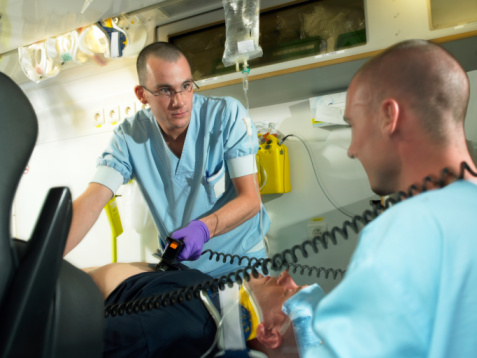
Unit 4-Bloodborne Pathogens
Post Exposure
Objectives:
After completion of this module, the learner will be able to:

After a report of an incident of exposure, the employer will immediately make available a confidential medical evaluation and follow-up to the employee that includes, at the least, the following elements:
1. Documentation of the route(s) of exposure, and the circumstances under which the exposure incident occurred.
2. Identification and documentation of the source individual, unless the employer can establish that identification is impractical or prohibited by state or local law. North Carolina statues require the source individual be tested. When the source individual is already known to be positive for HIV or HBV, the test does not need to be repeated. Results of tests are to be made available to the exposed employee, but he or she must be made aware of confidentiality requirements.
3. Collection and testing of the exposed employee's blood for HBV and HIV serological status, which means finding out if the virus is already present in the employee's blood. Collection must take place as soon as possible after the exposure incident to provide a baseline for diagnosis. Consent must be obtained from the employee prior to testing. If the employee refuses consent, the sample must be kept for at least 90 days to allow the employee to provide consent. as soon as consent is obtained, the sample must be tested. If the employee does not give consent, this should be documented. Current Centers for Disease Control(CDC), recommendations include testing the employee for evidence that the HIV is present in the blood at six-week, twelve-week, and six-month intervals if the source individual is HIV positive and if the employee's baseline test is negative.
4. Post-exposure prophylaxis, when medically indicated as recommended by the CDC.
5. Counseling: The employer must provide counseling about both the exposure incident and the medical follow-up, and must also provide psychological counseling if it is recommended by the healthcare professional.
6. Evaluation of reported illnesses: The exposed employee should be instructed to report and seek medical evaluation for any acute illness or any illness with a fever that occurs during the follow-up period. Following the post-exposure follow-up, the health care professional must provide the employer a written opinion including whether the hepatitis B vaccine is indicated and whether the employee received such vaccination. An opinion of what post-exposure evaluation and follow-up is needed. The employer must obtain this report and give a copy to the employee with in fifteen days after the evaluation is completed. All other findings or diagnoses must remain confidential and cannot be included in the written report. This provision of confidentiality may become a problem in small medical or dental offices where the employer serves as the health care professional for the employees. Using a physician outside the workplace is recommended in such situations. This report must note that the employee has been informed of the results of the evaluation and that the employee has been told of any medical conditions resulting from exposure to blood or other potentially infectious materials that require further evaluation or treatment.
If you have any questions at any time regarding the information presented in this tutorial, please contact David Sullivan at 910-916-0688.
(North Carolina Department of Labor (2010). A guide to bloodborne pathogens in the workplace.)

Occupational Exposure due to First Aid Administration
According to the standard, "occupational exposure" also applies to employees required by their employers to be trained in first aid and cardiopulmonary resuscitation (CPR) and identified to perform these types of medical assistance as collateral job duty. All of the provisions of the Bloodborne Pathogens standard cover these employees. Some of these provisions include, but not limited to, the requirement that the hepatitis B vaccine series be available at no cost and on a pre-exposure basis to these employees.
If you have any questions at any time regarding the information presented in this tutorial, please contact David Sullivan at 910-916-0688.
(North Carolina Department of Labor (2010). A guide to bloodborne pathogens in the workplace.)

Occupational Exposure due to First Aid Administration
An exemption to the Hep B pre-exposure vaccination is applied to those employees that only are in contact with blood would be the result of responding to a workplace related injury and this was a collateral duty of the employee and certain other requirements have been met. In contrast, the exception does not apply to those employees identified as first aid providers and render assistance on a regular basis; first aid station, clinic or location where injured employees routinely go for assistance are examples. This exemption also does not apply to any healthcare, emergency or public safety personnel expected to administer first aid in the course of their work. All of these employees must be offered the vaccine prior to exposure.
In order for the exemption to apply, the employer's control plan must explicitly address the provision of the hepatitis B vaccine to all unvaccinated first aid providers who give assistance in any situation involving the presence of blood or OPIM, (regardless of whether an actual "exposure incident" as defined by the standard occurred). The exposure control plan must also contain the provision that addresses the appropriate post-exposure evaluation, prophylaxis, and follow-up for those employees who experience an "exposure incident." To accomplish this, the employer's control plan must state a reporting procedure that establishes all first aid incidents involving the presence of blood or OPIM will be reported to the employer before the end of the work shift during which the incident occurred.
If you have any questions at any time regarding the information presented in this tutorial, please contact David Sullivan at 910-916-0688.
(North Carolina Department of Labor (2010). A guide to bloodborne pathogens in the workplace.)

Occupational Exposure due to First Aid Administration
The report for any first aid exposure incident must include the following: the first aid providers that gave assistance, indication if PPE was used, and a description of the first aid incident with date and time. This description shall contain the decision if this incident is considered an "exposure incident" according to the standard, and if blood or other potentially infectious materials were present. This determination is vital to select the appropriate post-exposure evaluation, prophylaxis and follow-up procedures which are mandatory to be made immediately available if an "exposure incident" occurs per the standard. The Bloodborne pathogens training program to first aid providers must also be included in the employer's control plan that contain the details of this reporting procedure.
If you have any questions at any time regarding the information presented in this tutorial, please contact David Sullivan at 910-916-0688.
(North Carolina Department of Labor (2010). A guide to bloodborne pathogens in the workplace.)

Occupational Exposure due to First Aid Administration
The Hep B vaccination series must also be available as soon as possible, but no later than twenty four hours, to unvaccinated first aid providers who have given assistance in the presence of blood or OPIM. This applies regardless to determination if an "exposure incident" has occurred or not.
Employees that give first aid assistance as Good Samaritans and not as a primary or collateral job function are not covered as "occupational exposure" as stated in the BBP standard, and thus are not required to be covered by the provisions. These instances should have appropriate post-exposure action according to state and local public health laws.
Now test your knowledge! You do not need a minimum score for any of the "Practice Time" Activities. These are to help review the material covered thus far!
Practice Time!
If you have any questions at any time regarding the information presented in this tutorial, please contact David Sullivan at 910-916-0688.
(North Carolina Department of Labor (2010). A guide to bloodborne pathogens in the workplace.)

If you have any questions at any time regarding the information presented in this tutorial, please contact David Sullivan at 910-916-0688.
(North Carolina Department of Labor (2010). A guide to bloodborne pathogens in the workplace.)
At the completion of this module, please make sure to choose both "Email Score", and "Print Certificate". For compliance, please include your job title after your name. The completed report ("Email Score") is emailed to the OSHA Services coordinator for record keeping, and the printed certificate is for your personal records.
Continue to the last module, "Unit 5- Exposure Procedures".